Oldest Bridges in the World – 10 Oldest Bridges Around the Globe
What is the oldest bridge in the world that is still in existence, and do we know about the first bridge ever built? While the first bridge ever built is most likely long gone, there are many old stone bridges that still exist today. In this article, we will explore the oldest bridges in the world and answer questions such as, “which country is home to the world’s oldest bridge”, and “what is the oldest type of bridge?”.
Table of Contents
- 1 What Is the Oldest Bridge in the World Still Standing?
- 1.1 Arkadiko Bridge (c. 1300 BCE)
- 1.2 Tarr Steps (c. 1000 BCE)
- 1.3 Bridge Over River Meles (c. 850 BCE)
- 1.4 Pons Fabricius (62 CE)
- 1.5 Alcántara Bridge (c. 106 CE)
- 1.6 Ponte Sant’Angelo (134 CE)
- 1.7 Cendere Bridge (c. 200 CE)
- 1.8 Band-e Kaisar (c. 270 CE)
- 1.9 Bridge Near Limyra (c. 3rd century)
- 1.10 Karamagara Bridge (c. 5th Century)
- 2 Frequently Asked Questions
What Is the Oldest Bridge in the World Still Standing?
While we may think of bridges as a convenience that has been around forever, this is not actually the case. Creating long-lasting bridges is a skill that took hundreds of years to develop and while there were early simple bridges made of wood, dirt, and stone, none of these have survived to the present day. There are, however, many old stone bridges made during the Roman era that still exist today.
This means that we can still examine and learn much about our past from the oldest bridges in the world in the present day.
Arkadiko Bridge (c. 1300 BCE)
| Period of Construction | c. 1300 BCE |
| Builder | Unknown |
| Status | Still in use |
| Location | Argolis, Greece |

The Arkadiko Bridge is a historic Mycenaean-era bridge in Greece’s Peloponnese area. It is the world’s oldest and best-preserved bridge, thought to date back to roughly 1300 BCE. The bridge is situated near the ancient city of Mycenae and was most likely created as part of a network of roadways and infrastructure that united the Mycenaean civilization’s many cities and communities. It spans the Arkadiko Choma, a tiny stream that feeds into the Inachos River.
The Arkadiko Bridge is constructed from massive limestone stones that were meticulously carved and joined together to create the arch and abutments.
The bridge is 22 meters in length and 5.28 meters wide. It was built employing the corbelling technique, which involves stacking stones one on top of the other and progressively narrowing toward the top to make the arch. It is also a significant archaeological site, providing insights into the Mycenaean civilization’s infrastructure and technological advances. The distinct layout of the bridge and the road alignment suggests that chariots could perhaps have utilized the bridge. The bridge is still being used by the locals three thousand years later.
Tarr Steps (c. 1000 BCE)
| Period of Construction | c. 1000 BCE |
| Builder | Unknown |
| Status | Still in use |
| Location | Exmoor National Park, Somerset, England |
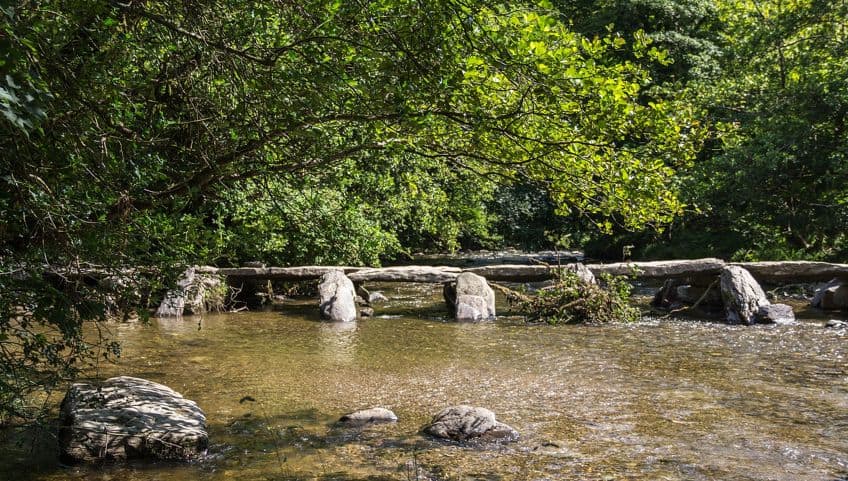
Tarr Steps is an ancient stone bridge in Somerset, England’s Exmoor National Park. The bridge is thought to date back all the way to the Bronze Period, circa 1000 BCE, making it among the oldest bridges in the world. The Tarr Steps are made up of 17 massive stone slabs that weigh up to two tonnes apiece and create a clapper bridge spanning the River Barle. The bridge is 55 meters long and broad enough to accommodate a single person across at a time.
The term “clapper” originates from the Medieval Latin “claperius” which translates to “pile of stones”.
It is an old style of bridge made of enormous unmortared stone slabs sitting on top of one another; this is the greatest example of its kind. It is thought that the bridge was erected to allow people to cross the river and have access to neighboring fields and supplies. According to local mythology, the Devil created the Tarr Steps to allow himself to sunbathe on the stones. Floods devastated the bridge in recent years, but it has since been restored.
The bridge is surrounded by magnificent woods and riverside trails, making it a popular hiking and wildlife destination.
Bridge Over River Meles (c. 850 BCE)
| Period of Construction | c. 850 BCE |
| Builder | Unknown |
| Status | Still in use |
| Location | Izmir, Turkey |
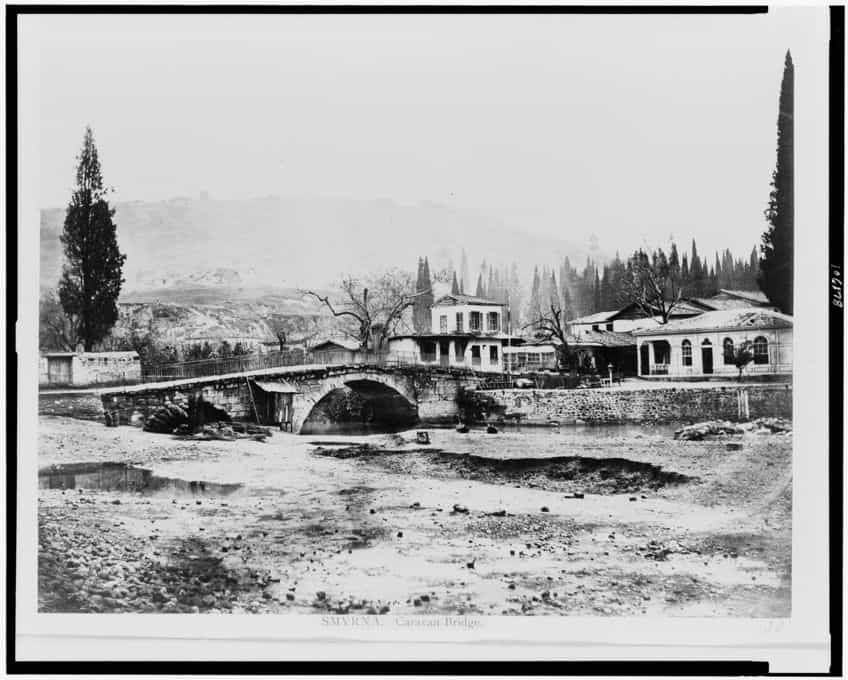
While there are some bridges that are significantly older, this famous bridge is the world’s oldest bridge still in service that can be accurately dated according to the Guinness Book of World Records. This historical arched stone slab bridge was erected in approximately 850 BCE. At one time, it functioned as the city of Izmir’s official entrance point.
This was Smyrna’s customs gate, and visitors would pause here for respite after a long journey and to see the Meles’ beautiful surroundings.
The River Meles is famous for being the birthplace of the renowned Ancient Greek author Homer, and both the bridge and the river appear frequently in his work. It was also named Caravan Bridge because it carried caravans across the Meles River. The existing stone bridge has a single 8.5-meter span.
Pons Fabricius (62 CE)
| Period of Construction | 62 CE |
| Builder | Lucius Fabricius |
| Status | Still in use |
| Location | Rome, Italy |

Pons Fabricius was erected to substitute an old wooden bridge that had burned down, according to Dio Cassius, a Roman historian. The bridge is noteworthy for being Rome’s oldest intact bridge as well as among the world’s oldest bridges. It was constructed from travertine stones and features two big arches separated by a smaller arch.
The bridge is further embellished with inscriptions and reliefs, including the builder’s name, Lucius Fabricius.
It has been in constant use since Roman antiquity and is completely undamaged. The Pons Fabricius is made up of two large arches that span 80 feet and are sustained by a pillar in the center of the stream. This bridge’s arches were the first non-semicircular arches on any Roman bridge. This might be due to the semi-circle being placed below the water line. Tuff was utilized to build the bridge’s core. A relief can be found 20 feet above the pier and functioned as an extra canal during floods.
Alcántara Bridge (c. 106 CE)
| Period of Construction | c. 106 CE |
| Builder | Caius Julius Lacer |
| Status | Still in use |
| Location | Alcántara, Spain |

Another Imperial Roman bridge that still stands today is the Alcántara Bridge. Trajan, The Roman Emperor, issued an order in 98 CE to build the stone arch bridge over the Tagus River. Alcántara Bridge construction started in 104 CE and was completed two years later. While the bridge is in decent condition now, it has been restored multiple times during its history. Over the years, it has sustained more damage from battle than from the environment.
One of the smaller arches was demolished by the Moors in 1214, but it was reconstructed centuries later, in 1543, using stone from the same quarries as the original.
The other arch on the northwestern side was later demolished by the Spanish in 1760 to prevent the Portuguese from approaching and was reconstructed by Charles III in 1762, before being blown up once again by Wellington’s soldiers hoping to delay the French troops in 1809. Provisional repairs were completed in 1819, but the Carlists demolished part of it again in 1836. It was then reconstructed using mortar brickwork in 1860.
Ponte Sant’Angelo (134 CE)
| Period of Construction | 134 CE |
| Builder | Roman Emperor Hadrian |
| Status | Still in use |
| Location | Rome, Italy |
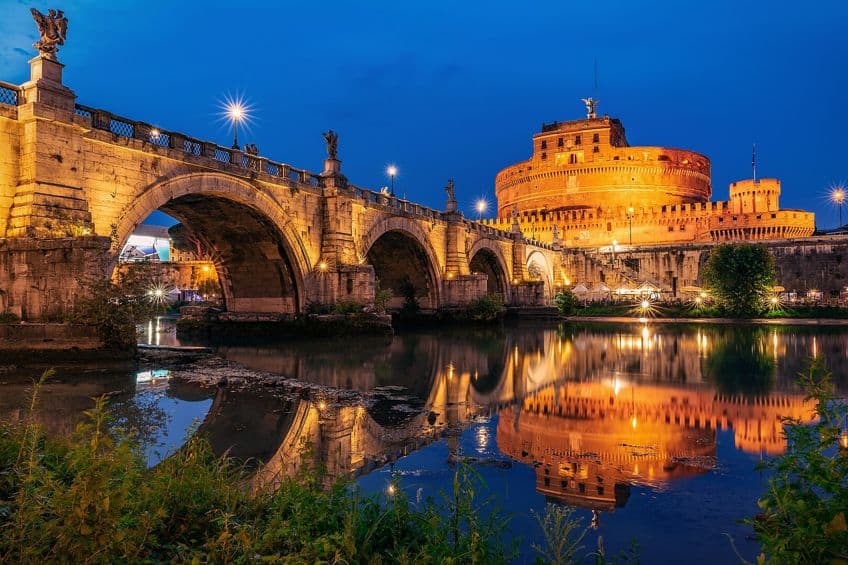
Ponte Sant’Angelo is a famous old bridge that spans the Tiber River in Rome, Italy. It was constructed as part of the Roman Emperor Hadrian’s tomb complex in 134 CE. The bridge was initially named Pons Aelius after Hadrian’s surname, but it was eventually renamed Ponte Sant’Angelo after a local chapel devoted it to the archangel Michael. The bridge is noted for its exquisite design and its 10 angel statues, which were installed by Pope Clement IX in the 17th century.
The statues represent numerous angels, each bearing a representation of Christ’s Passion, such as the crown of thorns, the crucifixion, and nails.
The bridge has been repaired on multiple occasions during its existence. It was extended in the 16th century to handle more traffic, and it was additionally reinforced with iron arches in the 19th century. Nowadays, Ponte Sant’Angelo is a renowned tourist attraction, affording breathtaking views of the Tiber River and nearby sites such as the Vatican City and the Castel Sant’Angelo. It also serves as a pedestrian-only bridge, so it’s a great location to walk about and take in the sights of Rome.
Cendere Bridge (c. 200 CE)
| Period of Construction | c. 200 CE |
| Builder | Roman Legio XVI Gallica |
| Status | Still in use |
| Location | Adiyaman Province, Turkey |

Septimius Severus fought the Parthians, took Ctesiphon, and brought Mesopotamia to Roman control in the opening years of the third century, prompting the construction of the Cendere Bridge. The ancient defensive line along the Upper Euphrates was no longer required. The territory was restructured, and in 200 CE, troops from the 17th Legion Flavia Firma built a new bridge across the river Chabinas. The bridge was built as a basic, unadorned solitary arch on two rocks at the creek’s narrowest point.
Two Corinthian columns on the Kâhta bank honor Septimius Severus and his wife, while two additional structures on the Sincik side honor Geta and Caracalla, all of which stand 9 to 10 meters tall.
Nevertheless, Geta’s column was removed following his assassination by Caracalla, his brother, who condemned Geta’s memory and ordered that his name be erased from all inscriptions. Cendere Bridge is located within one of Turkey’s most significant national parks. The bridge is permanently closed to traffic, and a modern road bridge has been constructed 500 meters east of the old one.
Band-e Kaisar (c. 270 CE)
| Period of Construction | c. 270 CE |
| Builder | Roman engineers |
| Status | Not in use |
| Location | Shushtar, Iran |
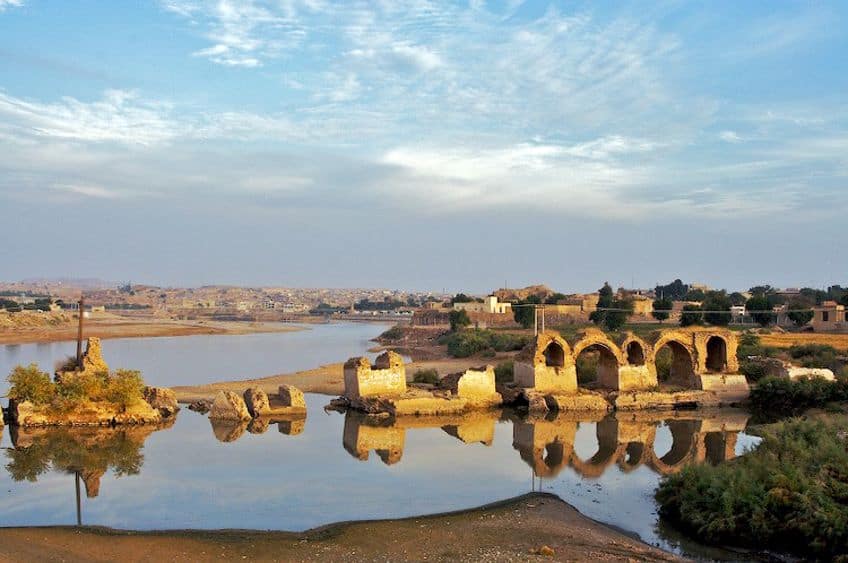
According to Persian legend, the Band-e Kaisar is named after Valerian, the Roman emperor, who was beaten at the Battle of Edessa and imprisoned by the Sassanid monarch Shapur I together with his whole army. The Roman engineering unit was part of a massive labor force that the victorious side utilized to construct in Shushtar, a significant agricultural hub in southwestern Iran. It may have comprised up to 70,000 men.
The bridge and dam were constructed together at the same time, making Band-e Kaisar the first of its type in the nation.
The bridge and dam, which were located deep into Persian territory, were the furthest eastern Roman examples of their kind. The incorporation of a structural system into a dam design, modeled after the Roman example, became a common practice of Persian hydraulic engineering that lasted until around 1000 CE when it culminated in the still-standing Band-e Amir at Shiraz. The structure has been described as a marvel of creative ingenuity by UNESCO. It also comprises Selastel Castle, a water level measuring tower, and a number of water mills, in addition to the hydraulic works.
Bridge Near Limyra (c. 3rd century)
| Period of Construction | c. 3rd century |
| Builder | Unknown |
| Status | Not in use |
| Location | Lycia, Turkey |
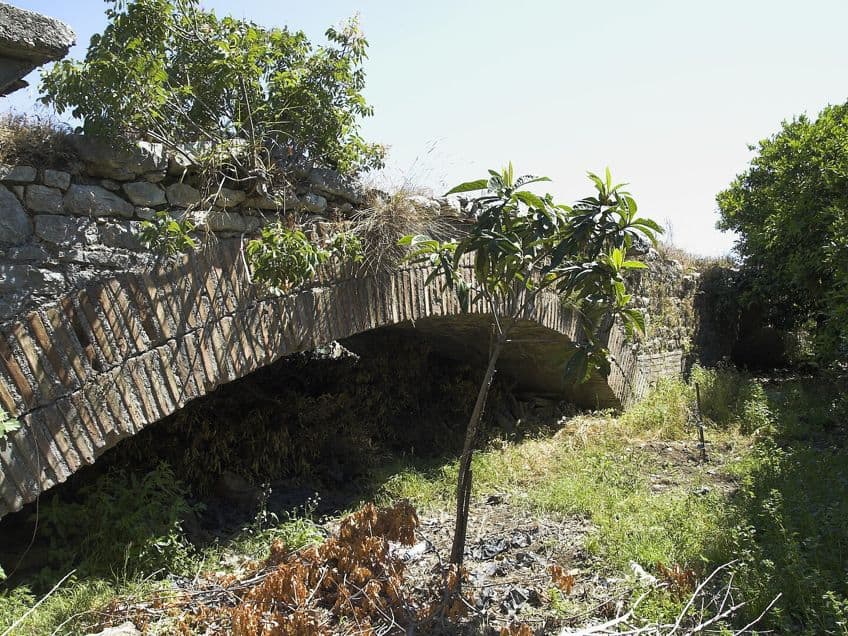
The Bridge Near Limyra is an essentially forgotten, though unusual stone bridge; it is said to be among the world’s oldest segmented arch bridges. It can be found close to Limyra, the ancient city, and is the region’s biggest antique civil engineering structure. The bridge’s arches were created in such a way that it has an extraordinarily flat profile, which was unusual in Roman engineering at the period. Owing to this aspect, as well as the absence of related constructions, it has been difficult to date the bridge’s construction, which is thought to have occurred somewhere in the third century.
Nevertheless, there has not been much scientific investigation on the bridge, and as such, there is very little documentation about the bridge from ancient sources.
The first and sole scientific inspection of the bridge was conducted over two consecutive days in September 1973 by German archaeologists Joachim Ganzert and Wolfgang W. Wurster and was followed by additional trips in subsequent years. The whole bridge was covered by river deposits up to the line of the vaults by the time the two visited the site. They made no attempts to unearth it.
Karamagara Bridge (c. 5th Century)
| Period of Construction | c. 5th century |
| Builder | Unknown |
| Status | Not in use |
| Location | Cappadocia, Turkey |
The Karamagara Bridge was constructed during the Byzantine Empire’s reign in the fifth or sixth centuries. The bridge was made up of a single pointed arch and is thought to be the first known instance of a pointed arch bridge. In fact, with the majority of Roman masonry bridges relying on semi-circular or segmental arches, it is not only an early example of pointed arches in late antique bridge design, but also throughout the history of architecture in general.
It was part of a larger Roman route that stretched to Melitene in Turkey’s Eastern Anatolia area. It is no longer functional due to being submerged after the Keban Dam was completed in 1975.
The Middle East Technical University of Ankara conducted an analysis of the Karamagara Bridge before it was submerged. Karamagara Bridge, in addition to other late Roman and Sassanian variants, largely found in early church construction in Mesopotamia and Syria, demonstrates the pre-Islamic origins of the pointed arch in the architecture of the Near East, which the Muslim occupiers later embraced and expanded on. In 1972, the stones with Greek inscriptions were taken from the bridge and transported to the Elazig Museum.
For thousands of years, bridges have served to make life more convenient for people, saving them from having to cross treacherous rivers and canyons, or from taking long detours to avoid them. Over the years, the process of creating bridges has been refined, yet many of the old stone bridges that served men thousands of years ago are still in use today. This stands as a remarkable testament to the men who designed and built these ancient structures all those centuries ago. Thanks to their achievements, mankind has been able to travel and traverse across challenging terrain through the years to facilitate trade, migration, and pilgrimages.
Frequently Asked Questions
What Is the Oldest Type of Bridge Still in Existence?
The first bridge ever built was most likely a fallen tree over a small river. From there, humans worked out how to refine the process, creating simple wooden structures. None of these still survive today, though, as wood does not last forever. Old stone bridges are the most likely to still be around, as stone does not deteriorate in the same conditions, and as long as they were placed in a manner that stops them from falling, a stone bridge can, and has, lasted for centuries.
Which Country Is Home to the World’s Oldest Bridge?
Many of the world’s oldest bridges were created in Rome. There are also many old bridges in places such as Turkey, which have a very long history. However, the country with the oldest bridge that still exists today is Greece! The bridge is called the Arkadiko Bridge and is believed to have been constructed at some point around 1300 BCE! Based on the design of the bridge, it has been speculated that it was built to accommodate the use of chariots as well! Despite its status as the world’s oldest bridge still standing, it is still regularly used right up to the present day by locals and tourists to the region.
Justin van Huyssteen is a freelance writer, novelist, and academic originally from Cape Town, South Africa. At present, he has a bachelor’s degree in English and literary theory and an honor’s degree in literary theory. He is currently working towards his master’s degree in literary theory with a focus on animal studies, critical theory, and semiotics within literature. As a novelist and freelancer, he often writes under the pen name L.C. Lupus.
Justin’s preferred literary movements include modern and postmodern literature with literary fiction and genre fiction like sci-fi, post-apocalyptic, and horror being of particular interest. His academia extends to his interest in prose and narratology. He enjoys analyzing a variety of mediums through a literary lens, such as graphic novels, film, and video games.
Justin is working for artincontext.org as an author and content writer since 2022. He is responsible for all blog posts about architecture, literature and poetry.
Learn more about Justin van Huyssteen and the Art in Context Team.
Cite this Article
Justin, van Huyssteen, “Oldest Bridges in the World – 10 Oldest Bridges Around the Globe.” Art in Context. August 15, 2023. URL: https://artincontext.org/oldest-bridges-in-the-world/
van Huyssteen, J. (2023, 15 August). Oldest Bridges in the World – 10 Oldest Bridges Around the Globe. Art in Context. https://artincontext.org/oldest-bridges-in-the-world/
van Huyssteen, Justin. “Oldest Bridges in the World – 10 Oldest Bridges Around the Globe.” Art in Context, August 15, 2023. https://artincontext.org/oldest-bridges-in-the-world/.









